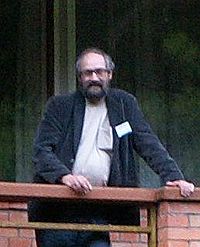Sergei Starostin
| Sergei Anatolyevich Starostin | |
|---|---|

Dr. Starostin on June 2, 2000
|
|
| Born |
March 24, 1953 Moscow, Russian SFSR |
| Died | September 30, 2005 (aged 52) Moscow, Russia |
| School | Moscow school, historical linguistics |
|
Main interests
|
long-range language reconstruction (especially Nostratic and Dené–Caucasian), , accentology (especially Indo-European) |
|
Notable ideas
|
Dené–Caucasian hypothesis, reconstruction of Proto-Altaic, Proto-North-Caucasian, Proto-Yeniseian, Proto-Tibeto-Burman, Proto-Kiranti, reconstruction of Old Chinese and Proto-Japanese, advancement of "recalibrated glottochronology" |
|
Influenced
|
|
Sergei Anatolyevich Starostin (Cyrillic: Серге́й Анато́льевич Ста́ростин, March 24, 1953 – September 30, 2005) was a Russian historical linguist, perhaps best known for his reconstructions of hypothetical proto-languages, including his work on the controversial Altaic theory, the formulation of the Dené–Caucasian hypothesis, and the proposal of a Borean language of still earlier date. He was also the author of a widely respected reconstruction of Old Chinese.
In 1986, Starostin and Igor M. Diakonoff suggested that the Hurro-Urartian languages belong to the Northeast Caucasian language family. Starostin was also instrumental in the reconstruction of Proto-Kiranti, Proto-Tibeto-Burman, Proto-Yeniseian, Proto-North-Caucasian, and Proto-Altaic. He developed the theory, originated by Abu al-Ghazi Bahadur Khan in the 17th century, but really revived by Gustaf John Ramstedt in the early 20th century, that Japanese is an Altaic language.
The Dené–Caucasian hypothesis proposes that Northwest Caucasian, Northeast Caucasian, Yeniseian, Sino-Tibetan, and Na-Dené form a single, higher-order language family. According to Starostin, the Dené–Caucasian and Austric macrofamilies, together with the Nostratic macrofamily (as envisaged by Vladislav Illich-Svitych, with some modifications), can further be linked at an earlier stage, which Starostin called the Borean (i.e. 'Northern') languages.
...
Wikipedia
